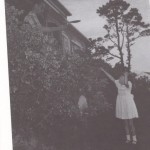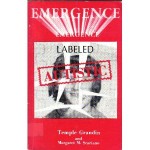Emergence Labeled Autistic by Temple Grandin
Temple Grandin’s first book, Emergence: Labeled Autistic (by Temple Grandin in liason with her ghost writerMargaret Scariano), was published in 1986 by Arena Press which was a publisher of Academic and Therapy publications.
When I learned in 1990 whilst qualifying as a teacher, I learned that my first book, Nobody Nowhere was to be published, I wanted to know if there were any other writers with autism in the world and heard via an autism professional (this was pre-internet boom) that there was one author before me, Temple Grandin, and was given the info that I could apply for a copy of her book as it was pretty much that kind of system… you couldn’t go into a shop and order or buy it like you can today. So I never got to read the 1986 version of Emergence published by Arena Press.
Nobody Nowhere came out in 1991, published by Transworld/Doubleday (now Random House) and became an instant international bestseller going number 1 in the USA, Canada, Japan, Norway. It spent over 10 weeks on the New York Times Bestseller List. Temple’s book, Emergence, was then updated the same year (1991).
In 1994, the sequel to Nobody Nowhere, Somebody Somewhere, became published, again an international bestseller, making number one in Canada, Japan and Norway and still a bestseller in the USA. By 1995, Nobody Nowhere was translated in over 20 languages around the world. I had by now become an autism consultant and public speaker and my first text book, Autism; An Inside Out Approach, was published as well as my first book of poetry, Not Just Anything.
Temple’s second book, Thinking in pictures : and Other Reports from My Life with Autism, was published by Vintage Books the same year (1995). Temple then became well known the same year after being described by Oliver Sacks in the title narrative of his book An Anthropologist on Mars (1995). A a year later, in 1996, her first book, Emergence, was then taken out of its ‘educational text’ status by Warner Books in 1996 and became widely available to the general public.
Now writing academic books, by 1998 I had moved to Jessica Kingsley Publishers and had two more books published in 1998, the third in the autobiographical series: Like Colour To The Blind, and a text book, Autism and Sensing; The Unlost Instinct. Then another text book; Exposure Anxiety; The Invisible Cage in 2003, the fourth in the autobiographical series; Everyday Heaven in 2004, and my third text book, The Jumbled Jigsaw in 2005 along with the republication of Not Just Anything.
The covers of the original 1986 version of Emergence: Labeled Autistic and the rewrite which then got published in 1996, come from completely different places, very different takes on autism. The original shows Temple’s smiling face, but the photo has been sliced up as if by scissors, shattered like its broken glass, against bright red alarmist background with a labeling stamp of ‘AUTISTIC’ stamped almost abusively across the eyes of Temple’s smiling 11 year old face.
By stark contrast, the cover in 1996 is of a girl in a field, arms out stretched in flowing floral garb as if celebrating nature and freedom. So now Temple’s autism was being repackaged as celebration, not tragedy.
. The cover changes were literally a big change of image. Sure, due to the publisher change and the goal of changing it from therapy text into mainstream book, but the changes probably also reflect the vast ways the field of autism had changed after 1991.
Have you read the 1986 version of Emergence Labeled Autistic as published by Arena Press before it was updated in 1991? Given Arena Press published Academic and Therapy publications, I wonder what was revised between 1986 and 1991 and whether those revisions were made to then allow it to become a mainstream publication by Warner Books in 1996. What was lost? What was added? It would be great to hear from anyone who had read both versions and what the differences were.
It is usual to rewrite a text book, after all one gains new knowledge. But an autobiography is different to a text book. An autobiography is a snap shot in time, a sort of ‘life as I saw it’. So its certainly not usual to rewrite an autobiography. It’s natural to ask why an autobiographer would do so for it is essentially a rewriting of one’s personal history. Did Temple’s ghostwriter, Margaret Scariano, have more input on the rewrite, or less?
Temple’s formal diagnosis was in adulthood, with Aspergers (her family had ‘diagnosed’ her with autism at age 4 (and then her teachers apparently also agreed with her family’s ‘diagnosis’ of autism). Her only other formal diagnosis was of brain damage at age 2, confirmed by MRI in 2010). It would be interesting to know if that formal diagnosis in adulthood was after 1986 and whether the 1991 rewrite was done in accordance with her formal diagnosis. If so how did she reflected on her autism before having a formal diagnosis of autism verses after having one.
Our backgrounds could not have been more different.  “Temple’s father wasn’t just any real estate agent. Richard Grandin was son of John Livingstone Grandin, owner of the largest corporate wheat farm in America (Grandin Farms of Pennsylvania was a gigantic business started by the Grandin ancestors, who initially were share-holders in the railroad businesses). The Grandin family wasn’t just rich – they were wealthy to the standards of Bill Gates today. The inventor grandfather was from the mother’s side. And he was part of the team that invented the autopilot system in use all throughout the aviation industry today. Suffice to say, that Temple was born into a family akin to the Microsoft/Hilton empire today”. My background by contrast was one of uneducated parents from large families who grew up in slums, born to itinerant, sometimes homeless parents. Temple continued her chain, I broke mine.
In my case my formal diagnosis when Nobody Nowhere was written was of Childhood Psychosis (age 2) and was made in a hospital in 1965 (Autism was called Childhood Psychosis in the 60s). Later diagnoses included Language Processing disorder around 1972. Dr Lawrie Bartak confirmed my autism diagnosis in adulthood but one year after I wrote Nobody Nowhere… so Nobody Nowhere is not influenced by knowing of my diagnosis in adulthood, it was written in an attempt to understand what kind of mad I was (ie what was this psychosis I’d had since age 2).
Donna Williams, BA Hons, Dip Ed.
Author, artist, singer-songwriter, screenwriter.
Autism consultant and public speaker.
http://www.myspace.com/nobodynowherethefilm
http://www.donnawilliams.net
http://www.aspinauts.com




[…] (by Temple Grandin and Margaret Scariano), was published in 1986 by a US university library. Full news story This entry was posted in HOT News and tagged temple grandin. Bookmark the permalink. ← […]